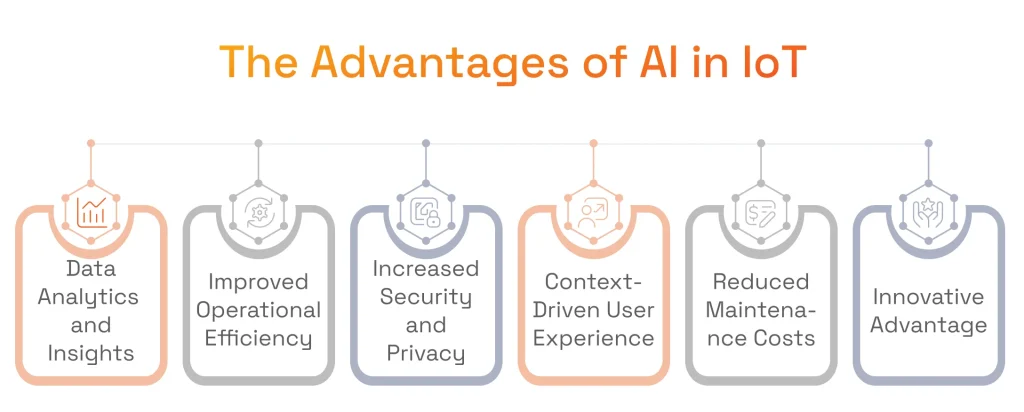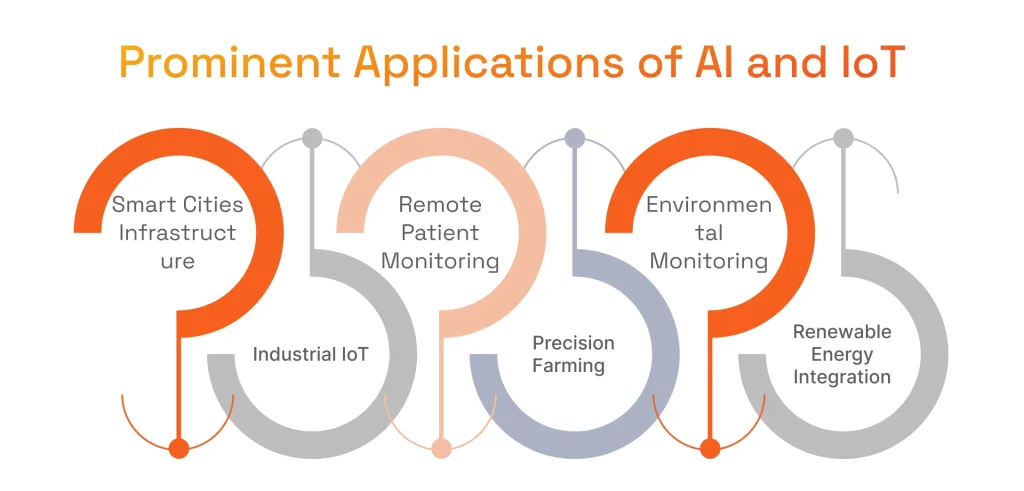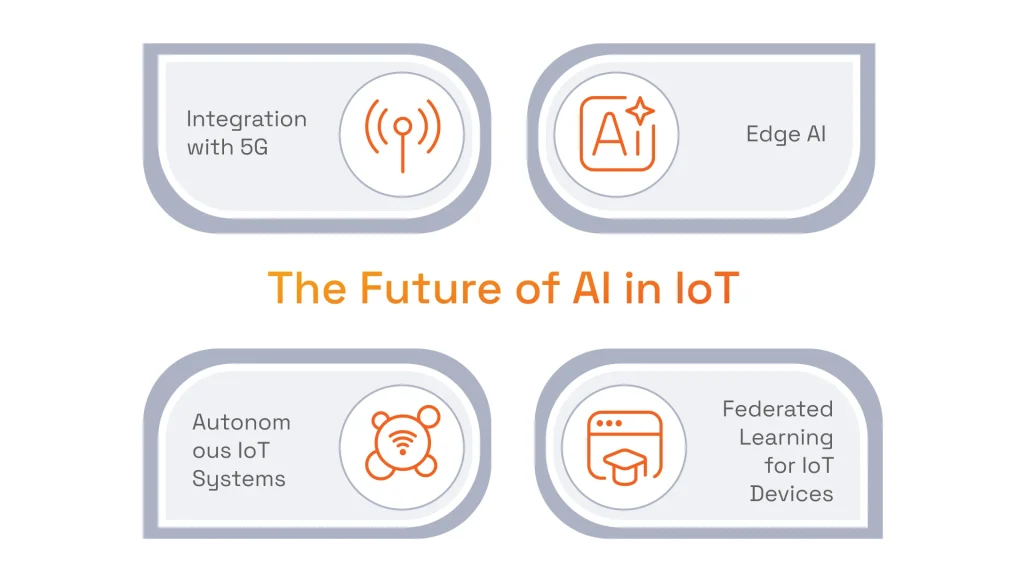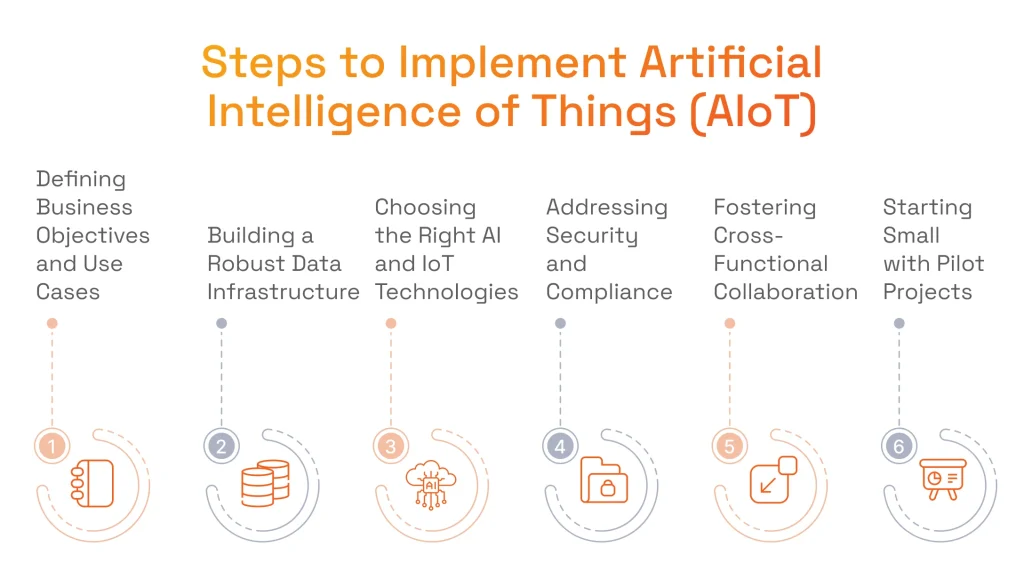While being massive revolutionary forces on their own, the tandem of AI and IoT has arrived to change the ways global organizations run their businesses. According to Market.us, the number of IoT devices will reach 75 billion globally in 2025, and the global AIoT(Artificial Intelligence of Things) market size is expected to grow to USD 168.8 Billion by 2033.
Indeed, there is a true value behind these numbers, as understanding, implementing, and leveraging AIoT will become crucial for some organizations to survive, optimize operations, increase revenue, and secure leading market positions.
In this article, we will discuss in great detail how Artificial Intelligence integration with IoT transforms businesses, as well as provide our practical insights on implementing this technology in the most efficient way possible.
AI and IoT: The Growing Trend of Artificial Intelligence of Things and Its Impact
Let’s discuss more closely, how Artificial Intelligence and Internet of Things are already benefiting global organizations, and how the combination of both can create even more value for those who are riding the wave of disrupting innovation.
Comprehending Artificial Intelligence
AI technologies, an essential part of computer science, excel at analyzing enormous sets of data, recognizing patterns, making predictions, and accurate decisions with minimal to no human intervention. Implementing Artificial Intelligence and Machine Learning algorithms is already an established way to improve operations, as 64% of businesses expect AI to increase productivity, according to Forbes.
Artificial Intelligence in Retail, eCommerce, Banking, Manufacturing, Insurance, Logistics, and Tourism, as well as many other industries, is doing wonders in shaping the future of organizations, so by itself this technology is already a true game changer.
For example, retailers successfully implement AI-based Visual Search, a technology that allows customers to upload images of products and find similar items in the store’s inventory almost instantly. For eCommerce platforms, AI can be beneficial in providing personalized product recommendations based on data collected on customer behavior, purchase history, and browsing patterns.
Banking, in turn, is one of the industries that benefit from sophisticated AI-driven Fraud Detection systems, uncovering suspicious patterns in real time that might be unrecognizable to human experts. Among many other use cases, examples of ai in logistics demonstrate the most efficient routes by analyzing traffic patterns, weather conditions, and delivery schedules.
Grasping the Internet of Things
IoT technology, on the other hand, is reshaping industries by enabling real-time monitoring, automation, and data-driven decision-making to lower maintenance costs for expensive equipment. IoT consists of devices embedded with sensors, software, and connectivity, allowing them to communicate with each other and central systems. These devices may range from everyday household items like smart thermostats and wearables to industrial machines and infrastructure.
With over 18 billion IoT devices connected worldwide in 2024, according to Statista, it is safe to assume that this technology will enter every aspect of our lives, impacting businesses on the global scale as well.
The Transformative Advantages of AI in IoT
Each of these technologies has already proven its worth, however, they are even more powerful when working together and elevating operational efficiency for businesses. The convergence of IoT and AI is giving rise to a new paradigm known as the Artificial Intelligence of Things (AIoT). It has become a separate market of its own, expected to grow to USD 253.86 billion by 2030, as reported by Fortune Business Insights.

These two technologies are a perfect match for delivering ultimate value for organizations, so let’s highlight the most prominent advantages of their combination.
Enhanced Data Analytics and Insights
AI is capable of quick data analytics and processing of large amounts of information, it’s capable of analyzing video streams, for example, which is very resource-consuming. With the addition of cloud computing, AI gains the ability to transfer data fast, providing real-time insights and allowing organizations to make immediate, informed decisions.
Speaking of cloud computing, we recommend you read our article on the benefits of cloud computing infrastructure to find out how to maximize the results of this technology.

Serhii Leleko
ML & AI Engineer at SPD Technology
“The core concept of this combination lies in the fact that IoT generates vast amounts of data from different sources, while AI leverages its capabilities for advanced data analysis and processing. Based on our completed projects, we know how AIoT can benefit enterprise users, while at the same time, it can be applicable and beneficial for businesses of any scale.”
Improved Operational Efficiency
AI is a great technology for automating routine tasks, reducing manual labor, and enhancing productivity. This automation optimizes resource allocation as well, letting your human resources focus on more strategic tasks. We already discussed the advantages of strategic technology consulting, so if you want to maximize the efficiency of the IoT and AI implementation, it makes sense to consult with vetted experts in this area for the best results.
Increased Security and Privacy
With AI, it is possible to detect anomalies and potential security breaches in real-time, enabling timely responses to mitigate risks. AI algorithms can be programmed to analyze specific patterns and behaviors to identify fraudulent activities, protecting businesses and consumers from massive financial losses.
Context-Driven User Experience
It is possible to achieve unprecedented levels of personalization, by tailoring content and services perfectly aligned to user preferences, resulting in higher levels of user engagement and satisfaction. For instance, NLP and AI can offer outstanding human-machine interactions via sophisticated chatbots and virtual assistants.
Reduced Maintenance Costs
By predictive equipment failures and optimizing maintenance schedules, AI can prevent costly breakdowns and downtime. Not only this technology is helping to maintain the assets, but also it is capable of identifying the most effective maintenance strategies to prolong the asset lifecycle.
Innovation and Competitive Advantage
Integrating AI with IoT enables the development of new business models and services that will help your organization stand out among the competition. AI also enhances an organization’s ability to respond quickly to market changes and emerging trends, helping not only get on top but also stay there.
Businesses of any size can benefit from the combination of AI and IoT, however, on the enterprise level, the efficiency from this tandem will be the most impactful.
Building an enterprise data strategy is the first step towards this goal – discover how to do it in our dedicated article!
Prominent Applications of AI and IoT
IoT and Artificial Intelligence are taking some industries by storm, by offering highly effective solutions to common problems. Here is a breakdown of the most interesting use cases.

Smart Cities Infrastructure
Artificial Intelligence and Machine Learning are the two technologies that make modern cities smart. While smart sensors and connected devices do their magic in getting the information, AI is the brain behind the operation.
Public safety
According to Statista, the size of the global computer vision market is projected to reach USD 25.80 billion in 2024. For Smart Cities, this growth means more availability of technology for use cases like AI-powered surveillance systems to analyze video feeds from IoT-enabled cameras to detect unusual activities, alert authorities, and enhance public safety.
We have a vetted team that is capable of delivering Computer Vision development services of any complexity, so if you have a project related to this technology in mind, our experts would be glad to help you.
Traffic management
The option to monitor traffic flow is another interesting use case of IoT and AI based on video data streams. This can significantly reduce traffic flux and minimize emissions. Furthermore, combined with Smart Traffic Lights, AI can optimize its timing and improve transportation efficiency as well.
Waste management
IoT-enabled waste bins equipped with sensors can easily monitor fill levels and optimize waste collection routes. With the addition of Artificial Intelligence and Machine Learning, this process will be even more efficient, helping to reduce operational costs and minimize environmental impact.
Industrial IoT
Shopogolix believes that AI in the IoT market is expected to grow at a CAGR of 26% to reach USD 16.2 billion this year, mainly as a result of the increased integration of Artificial Intelligence and Machine Learning in Industrial IoT and wider adoption of the following applications.
Predictive Maintenance
AI and Predictive Maintenance allow organizations to achieve massive cost savings by extending the life of expensive equipment. IoT sensors can monitor equipment health in real-time, collecting data on vibrations, temperature, and other required parameters. AI algorithms analyze sensor data to predict equipment failures before they occur, enabling proactive maintenance and minimizing downtime.
Process optimization
The production processes can be improved and optimized as well. With the help of Artificial Intelligence of Things, it is possible to analyze data right on the factory floor, leading to improved quality control, reduced waste, and enhanced overall efficiency.
Supply chain management
IoT devices including sensors and trackers allow for effective real-time monitoring of resources in a supply chain. Combined with Artificial Intelligence, supply chain management can benefit from advanced analytics, adapting to evolving customer needs faster. If Harvard Business Review is to be believed, Artificial Intelligence and Machine Learning have the potential to reduce stockouts by 50%.
Are you interested in learning more about Artificial Intelligence in Manufacturing?
Read our article, as we shared our hands-on experience and highlighted the most interesting real-world use cases!
Remote Patient Monitoring
Advanced Applications of Machine Learning in Healthcare have already proven their worth in saving lives, however, combined with IoT devices, use cases like remote patient monitoring become available, providing real-time insights into patients’ health and improving care delivery based on dynamically changing patient data.
Chronic disease management
Artificial Intelligence helps to make sense of data generated by wearable devices that monitor vital signs such as heart rate, blood pressure, and glucose levels. Advanced data analytics that AI introduces, helps to detect anomalies and provide personalized insights, allowing patients to manage chronic conditions more effectively.
Telemedicine
IoT devices already make remote healthcare possible, helping to exchange data faster and allowing doctors to make correct and timely decisions. With AI capabilities, medical experts can make even more accurate assessments and leverage AI-assisted treatment recommendations.
Emergency response
With IoT, it is possible to collect data from medical devices, helping to detect and alert on several critical health conditions including seizures or heart attacks. Integrating AI into this process, allows medical experts to prioritize alerts on the severity of each emergency, ensuring timely responses to the ones who need it the most.
Precision Farming
We already touched on the topic of AI and ML in the Food industry in one of our articles, as agriculture is a big part of it. Valuable insights, based on data collected from IoT, are enabling precision farming, optimizing crop production and resource management. Let’s explore the promising application of AI and IoT in the farming sector in more detail.
Crop monitoring
It is already a quite common technology integration when IoT sensors collect data on soil moisture, temperature, and nutrient levels. However, when Artificial Intelligence is offering its real-time data analysis, farmers can benefit greatly from tailored recommendations on irrigation, fertilization, and pest control, optimizing crop yield and overall usage of resources.
Livestock management
Internet of Things and Artificial Intelligence allow not only to monitor the health and behavior of livestock, but also, thanks to data analysis, detect early signs of illness, optimize feeding schedules, and improve animal welfare.
Environmental Monitoring
Smart environmental sensors can make a big difference in helping to solve environmental challenges, particularly by providing real-time insights into natural ecosystems.
Air and water quality monitoring
AI in Internet of Things allows for collecting precise data on pollutants and contaminants, while at the same time conducting data analysis, identifying pollution sources, assessing environmental impact, and supporting regulatory compliance. This use case alone can be invaluable for ecology.
Wildlife conservation
AIoT applications can help protect wild species and their habitats as well by monitoring the movement of wildlife and providing information for conservation efforts and strategies. AI can effectively identify hidden patterns and detect threats that may be missed by human intelligence.
Disaster management
As we live in the era of climate change, this particular use case is very important. The technology allows specialists to sense real-world conditions and monitor temperature, humidity, and seismic activity. This makes it possible to enable early warning systems, conduct proactive response measures, and, ultimately, predict natural disasters.
Renewable Energy Integration
The Energy Industry is another important area, where technology truly shines, helping to drive innovations forward, leading to massive cost savings for organizations. According to Allied Market Research, the global AI in Renewable Energy market size is projected to reach USD 4.6 billion by 2032, so the future looks very promising.
Energy management
When businesses opt for AI-driven data analytics services, they get the possibility to optimize energy consumption, provide effective monitoring activities in real time, adjust energy usage, and recommend energy-saving measures.
Smart grid
With all data generated on energy production and distribution, Artificial Intelligence can analyze this data to optimize grid operations, balance supply and demand, and significantly reduce energy losses.
Implementations of AI in the energy sector are already disrupting traditional approaches.
Discover the most interesting use cases in our article, and find out how the innovations can benefit your organization!
Future Outlook of AI in IoT
The future of both domains looks very bright, as the advancements in technology and the rise in computing power will boost the efficiency of AI and IoT projects even further. Let’s take a look at the most promising trends.

Integration with 5G
According to GSMA Intelligence, the number of 5G connections surpassed 1.5 billion at the end of 2023. IoT networks are benefiting greatly from this astonishing growth, having access to faster data transmission speed, lower latency, and more reliable connections.
In particular, the areas that will benefit from 5G improvements include:
- Quicker and more accurate decision-making thanks to enhanced bandwidth and reduced latency that allows IoT devices to process and analyze data in real-time.
- A more comprehensive data collection and analysis due to 5G’s capacity to support a vast number of connected devices.
- Significantly better remote control and monitoring of IoT devices.
Faster data exchange unlocks the benefit of another growing technology, increasing the business impact of Big Data for organizations as well.
By the way, Artificial Intelligence can improve 5G connectivity itself with the help of AI-optimized network slicing. AI can be used for managing and optimizing network slices in 5G networks, ensuring efficient and reliable communication for various IoT applications.
Edge AI
Being another promising trend, Edge AI is all about deploying AI algorithms on IoT devices themselves rather than relying on centralized cloud servers. Implementation of Edge Computing reduces latency by processing data locally, while also enhancing the privacy of sensitive data. Additionally, Edge AI improves the overall reliability of IoT systems, ensuring that critical functions can run without disruptions even when the internet connection is gone.
Autonomous IoT Systems
Self-managing IoT systems that use AI to autonomously monitor, diagnose, and optimize their operation with minimal human interaction, are set to be at the forefront of industrial automation. If ScienceDirect is to be believed, the autonomous IoT systems adoption is currently divided between industries in the following way:
- 30% Transportation
- 21% Military and Security
- 19% Aerospace
- 16% of Healthcare
- 14% Home robotics.
Implementing AI for autonomous IoT systems allows them to make intelligent decisions based on real-time data, enhancing efficiency and effectiveness. Most importantly, AI-powered IoT devices can scale efficiently, adapting to changing conditions and demands without requiring significant human oversight.
Federated Learning for IoT Devices
This is another growing trend that you should keep an eye on, a decentralized Machine Learning approach where multiple IoT devices collaboratively train a shared model while keeping the data on the devices themselves, rather than transferring the data to a central server. This technique preserves user privacy by keeping data on local devices and complying with data protection regulations. It also reduces bandwidth usage by sharing only model updates rather than raw data.
Getting Ready for Artificial Internet of Things Implementation – Critical Steps
Before investing in any kind of AI & IoT initiative, it makes sense to prepare your organization to be able to handle this injection of innovation with maximum efficiency and minimal disruptions. In this section, we will share a step-by-step process to be guided by when implementing IoT combined with AI.

1. Defining Business Objectives and Use Cases
It makes sense to start with identifying what exact business goals and problems an AIoT solution should be aimed at in your organization. You should see measurable outcomes and prioritize the most impactful use cases that correlate with high-level goals in your organization. Creating a well-defined roadmap helps ensure that the AIoT implementation delivers tangible business value with the biggest ROI.
2. Building a Robust Data Infrastructure
Next, establish a reliable and scalable ecosystem, which should include the following crucial components:
- IoT devices for real-time data collection
- Data warehouses for centralized storage of large volumes of data
- Advanced computing platforms to process and analyze data efficiently.
In our recent article, we discussed how to build a data warehouse in such a way that it serves as a solid foundation for your future AI and IoT initiatives!
3. Choosing the Right AI and IoT Technologies
With the goals and infrastructure in place, it’s time to choose the most suitable interoperable, scalable tools and platforms to match both the technical and business requirements. You should consider trending technologies and approaches to future-proof your solution. While choosing your tech stack, pay attention to connectivity, device compatibility, and ability to integrate with existing software.
4. Addressing Security and Compliance
While working with data, there can’t be too much emphasis on security and compliance. The common practice is to develop a strong security framework that includes end-to-end encryption, regular updates for IoT devices, and is compliant with the latest data protection regulations.
5. Fostering Cross-Functional Collaboration
Another key element to the success of your AIoT initiative is alignment across all departments that are related to this innovation. The departments may include various IT, operational, and business units, as well as upper management. The common practices to enable cross-departmental collaboration include:
- Unified communication channels
- Regular planning sessions
- The introduction of cross-functional teams
6. Starting Small with Pilot Projects
Finally, start small by testing new technologies, models, workflows, and approaches on a small scale. By leveraging pilot projects, you will be able to collect necessary insights, improve strategies, and address numerous challenges of AIoT. When you make the necessary adjustments, slowly scale up your initiative to ensure smooth integration without any significant disruptions.
Obstacles in Combining AI with IoT
While the combination of AI and IoT has seemingly limitless potential applications across various industries, there are still some major challenges that need to be addressed.
Data Integration Complexity
Let’s start by mentioning the complexity of data integration that is quite common in the IoT Artificial Intelligence realm. Since IoT devices generate enormous amounts of data from entirely different sources and in various formats, making sense of it all is always a challenge. Furthermore, Artificial Intelligence and Machine Learning solutions require this data to be properly prepared, to use it for AIoT applications.

Serhii Leleko
ML & AI Engineer at SPD Technology
“In our projects, at SPD Technology, we always implement standardized data protocols and employ data lakes that can store large volumes of structured and unstructured data to deal with this challenge. We utilize advanced data processing tools to ensure seamless preprocessing and integration of data before it is fed into AI models.”
Scalability Issues
With the gradual expansion of the number of IoT sensors and devices, scalability becomes another notable challenge for IoT networks powered by AI algorithms. Traditional centralized cloud computing approaches may struggle with this task, so it makes sense to employ Edge Analytics to process data closer to the source, reducing latency and the load on centralized servers.
Our experts deal with this issue by employing Edge Analytics to process data as close to the source as possible, reducing latency and the load on centralized servers.
Security Concerns
Some IoT devices may have limited security features, while AI algorithms can be vulnerable to constantly evolving attacks from cybercriminals. Ultimately, the data collection process for AIoT applications may be in danger, putting extremely sensitive information at risk. We always prioritize the safety of information, implementing robust security measures and encryption protocols to protect data both in transit and at rest. Our experts conduct regular security audits to provide timely security updates for IoT devices and AI systems, protecting transmitted and collected data as much as possible.
Resource Constraints
There are some limitations on IoT devices, for example, limited processing power, memory, or battery life. These limitations can make it hard to run complex AI algorithms directly on devices, failing to utilize the fullest potential of Artificial Intelligence of Things.
There is a way to deal with resource constraints and ensure efficient IoT operations with less powerful devices. We have hands-on experience in developing lightweight AI algorithms and models tailored for specific IoT devices. Our team implements a variety of techniques, including model compression and quantization, to reduce the size and computational requirements of AI models.
Interoperability
Finally, there is a challenge with the diversity of the available IoT devices, platforms, and communications protocols. To enhance interoperability, organizations should set standards and protocols that facilitate data processing and transmission. Implementing middleware software can help bridge the gap between disparate systems, being another viable solution to this challenge.
To enhance interoperability, we leverage standards and protocols that facilitate data processing and transmission. By implementing middleware software, we bridge the gap between disparate systems.
Why Harnessing Innovative Technologies Requires a Pro Approach
Since AIoT projects are complex and specific, joining forces with true professionals will provide you access to all necessary technologies and tools to drive innovations and future-proof your organization. Only with proficient experts, you will be able to implement advanced technologies and introduce efficient development processes.
With professional involvement, you will also improve the efficiency of the data infrastructure, making sure that the systems are scalable, and optimized for peak performance and integration of third-party solutions.
The professional vendor knows how to address possible security issues and adhere to the latest industry standards. Preserving the highest level of security is critical in 2025 since concerns over data breaches and regulatory compliance are only growing.
Finally, having a skilled team at your side will boost the speed of development. The combination of optimized workflows and domain-specific expertise will help bring the most complex projects to life faster.
Consider SPD Technology as Your AI in IoT Integration Partner
We, at SPD Technology, will ensure that the implementation of AI/IoT will improve the efficiency of your organization and provide you with tangible and explainable results. Having a large, proven history of completed projects, we bring in narrow experience and knowledge of the nuances and complexities of the world of AI and IoT.
In all of our projects, we hold security at the utmost importance, as we adhere to the best practices and latest industry standards, protecting the information of our clients at every stage of their projects.
We build our solutions to cover not only the present but also the future needs of our customers, scaling software along with their businesses. For some of our clients, we became permanent software developers, being a natural extension of their businesses for many years.
SPD Technology’s AI and IoT Projects – Success Stories
Speaking of our most interesting projects, here are just a couple of examples of how our involvement transformed the businesses of our customers and leveraged AI-powered insights for IoT optimization.
Developing the World’s First Software-Defined Connectivity (SDC) Solution
Business Challenge
Our client is BD Innovations, the Israeli telecom technology leader, which was acquired by the UK-based innovative connectivity provider floLIVE. The challenge we were tasked to handle was to develop the Rater Engine, one of the modules in floLIVE’s cloud-based connectivity enablement platform, specifically designed for IoT Software-as-a-Service providers.
SPD Technology Approach
To reach the goals of this project, we assembled a team of 20 exceptional experts experienced in finance and eCommerce industries. The telecom industry was new to them, however, informal sessions with the client’s Solution Architect provided invaluable domain insights and allowed our team to truly shine in this project.
We developed Rater Engine 3.0, a cutting-edge billing solution that combined the client’s BBS system with modern functionality. While the client chose the initial tech stack, we suggested the more effective tech choices including Kotlin, Kafka, PostgreSQL, and Spring Framework.
Early performance of the system was limited to 200 requests/second without caching. Our introduction of Apache Ignite increased capacity to 2,300 requests/second. Further optimization with Hazelcast achieved over 5,000 requests/second.
We tested the system on databases with over 1 million users and got excellent results. Maintaining continuous refactoring allows for a highly adaptable and efficient system with no legacy code.
Value Delivered
- Improved Customer Satisfaction: our new version of the client’s billing system, which we developed from scratch, completely outperformed the previous solutions that our client had and completely overhauled the customer experience with new convenient functionality.
- Acquiring New Customers: the new solution we delivered helped the client increase the number of B2B customers, and recently the platform has started being used as a white-label product by a major Western ICT provider.
Developing the world’s first software-defined connectivity solution truly showcased the proficiency of our experts in IoT and cloud development. With our cutting-edge software, the client successfully raised $37 million in Series B funding with the backing of global-leading investors.
How We Delivered a Full-Fledged, AI/ML-Powered Defect Prevention System for Equipment Inspection
Business Challenge
Our client is a US-based company offering inspection services for equipment. The company operates in a growing number of industries, currently including energy management, oil and gas, power transmission, construction, and manufacturing. The challenge was to create an AI-driven inspection platform that would be able to automate and improve the efforts of human experts.
SPD Technology Approach
To achieve the goal of this project, we built a modular data collection system compatible with multiple sensors, cameras, and an Android app for capturing and transmitting images, videos, and maintenance notes. For data processing, we used NLP algorithms for text extraction and YOLO models with neural networks for visual defect detection. Complex sensor data recognition tasks were handled by advanced machine learning techniques.
We engineered efficient defect detection functionality by setting anomaly models to flag deviations in equipment behavior, notifying of potential failures, and working basically as an anomaly detection with machine learning algorithms. Our deep learning models are able to detect several types of defects including cracks and corrosion, assigning an AI-powered health score to assets for comprehensive condition monitoring.
In this project, we also incorporated digital twins using a 3D engine to visualize equipment and defects interactively. In another effort to help human experts, we introduced an NLP-powered chatbot utilizing RAG-provided contextual guidance.
Finally, we implemented automated reporting functionality that utilizes visual data, defect insights, health scores, and maintenance history.
Value Delivered
- Boosted Efficiency: our custom AI-driven platform helped to elevate the efficiency of human experts to an entirely new level by automating critical tasks and providing real-time insights, allowing inspectors to optimize their work and complete inspections faster.
- Cost Reduction: the early defect detection functionality that our platform offers helps to prevent costly breakdowns for its users and plan timely maintenance activities.
In this project, we delivered an innovative, feature-rich AI platform for defect detection that showcased the effectiveness of cutting-edge technologies, including AI/ML, NLP, object recognition, anomaly detection, video and image analysis, as well as sensor data analysis.
Conclusion
Artificial Intelligence of Things, the combination of the two trending technologies, AI and IoT, is bringing unprecedented levels of intelligence, efficiency, and security to global businesses. While AI and IoT serve distinct roles, their synergy means leveraging IoT’s data-gathering capabilities and AI’s analytical prowess to create smarter, more responsive systems that revolutionize traditional ways.
In the coming years, we should expect the fusion of AI and IoT to continue changing the world and driving innovation for organizations in entirely different industries. We, at SPD Technology, are here to embrace the adoption of modern technology and help your company to strive in a competitive and data-driven world.
FAQ
What industries benefit most from AI and IoT?
The sectors that benefit from Artificial Intelligence and the Internet of Things the most include manufacturing, healthcare, agriculture, retail, logistics, and energy. These industries leverage AI for IoT to streamline core operations, lower expenses, and provide more informed information for decision makers.
Is AIoT secure?
IoT with AI integration can be secure, but to achieve this, it should be implemented by a team of professionals. However, AI IoT devices remain in danger of data breaches and hacker attacks, so vendors should continuously provide practices like encryption and software updates.
How AI and IoT are used in inventory management?
In inventory management, AI and the Internet of Things automate critical supply chain operations and significantly reduce human error. This is achieved thanks to real-time stock tracking, optimizing warehouse layouts, and leveraging demand forecasting.
How to take advantage of IoT and AI capabilities?
To maximize the benefits of IoT and AI integration, organizations should clearly define specific use cases, ensure access to high-quality data, and be prepared to train staff to operate with innovative solutions. Step-by-step approach and guidance by a proven IoT and Artificial Intelligence vendor will unlock the fullest potential of the technology.
